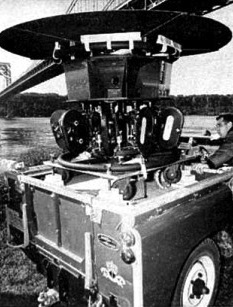Tuesday, April 29, 1986.
AT FIRST, MOVIE SCREENS were flat and sort of square. After a while, though, the excitement wore off and people realized that they were just movies, after all.
To rekindle audience enthusiasm somebody decided to make the screen wider. Somebody else suggested that they give it a bit of a curve.
Curve a screen enough and you'll get a circle. At Montreal's Man and His World, Walt Disney introduced a process called Circle-Vision 360 — actually nine screens separated just enough to accommodate nine projector ports — with a film called Canada 67.
Disney, working for the Telephone Pavilion, had reinvented the wheel, and audiences loved it. His patriotic, all-around-you look at our land became one of the Canadian Centennial show's biggest crowd-pleasers.
In keeping with its transportation theme, Expo 86 has not one but four cinematic wheels designed to turn fairgoers' heads. The Czechs, improving on the basic idea, have come up with Rondovision for their national pavilion.
The process is used to greet visitors to the Czechoslovakian Pavilion and offer them a look at that country's scenic wonders on a seamless 360-degree screen. A single-projector system, Rondovision makes use of a ring-shaped mirror mounted in the centre of the ceiling to direct the image to the screen.
Another seamless scene surrounds visitors to the Quebec Pavilion. Here, though, the projection machinery — a combination of slide and movie projectors — is contained in a gondola suspended from the ceiling at the centre of the circle.
The Singapore Pavilion has a two-wheel presentation. A 33-projector slide show on a double ring of screens, Surprising Singapore highlights the city's multi-racial culture.
Finally, the ever-popular Circle-Vision 360 is back with a new, 18-minute production, Portraits of Canada. It can be seen at the Telecom Canada Pavilion.
The above is a restored version of a Province Expo 86 preview feature by Michael Walsh originally published in 1986. For additional information on this archived material, please visit my FAQ.
Afterword: As it turns out, Walt Disney wasn't the first to surround a world's fair audience with movie screens. That distinction goes to French-born movie pioneer Raoul Grimoin-Sanson. In 1897, he patented a 10-camera, 70mm cinematic process he called Cinéorama. Grimoin-Sanson loaded his apparatus into the basket of a hot-air balloon and recorded its ascent to some 400 metres above the French capital's Jardin des Tuileries. The resulting film, projected on a 360° screen, provided visitors to the 1900 Paris Exposition Universelle with the experience of a simulated flight. Unfortunately, there were serious heat problems associated with the projection system's arc lights, and Cinéorama was never used again.
The Disney version, originally called Circarama, was an 11-camera, 16mm process. The story is told that Disney came up with the idea after seeing the 1952 feature This Is Cinerama, an ultra-widescreen film shown on three screens. His first full-circle film, A Tour of the West, made its debut in a purpose-built theatre at Disneyland on the theme park's opening day in 1955. The process reduced the number of its cameras (and projectors) to nine in 1960. Its name was changed to Circle-Vision in 1967, after lawyers for the Cinerama company suggested that Circarama came seriously close to copyright infringement.
Disney soon took his new show on the road, producing Italia 61 for the auto manufacturer Fiat's pavilion at Turin's Expo 61. As mentioned above, the Montreal Expo film, the 22-minute Canada 67, was a big hit, as was the 18-minute Portraits of Canada, shown at Expo 86. The movie seen at the Vancouver fair is credited to Theme Park Productions, a Disney subsidiary created to serve the special-venue market. In a neat bit of film financing, Theme Park's pictures are made for corporate sponsors — Portraits of Canada screened at the Telecom Canada Pavilion — and then enjoy an afterlife as Circle-Vision Theatre attractions at the growing network of Disney theme parks.
See also: The 13 articles included in this, the first of four Expo 86 special reports, are:
